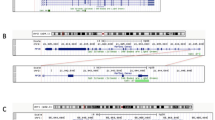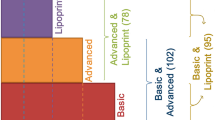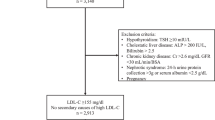Abstract
Children with familial hypercholesterolemia (FH) exhibit substantial variance of LDL cholesterol. In previous studies, family members of children with FH were included, which may have influenced results. To avoid such bias, we studied phenotype in 450 unrelated children with FH and in 154 affected sib-pairs. In known families with classical FH, diagnosis was based on plasma LDL cholesterol above the age- and gender-specific 95th percentile. Girls had 0.47 ± 0.15 mmol/L higher LDL cholesterol, compared with boys (p = 0.002). Also in girls, HDL cholesterol increased by 0.07 ± 0.03 mmol/L per 5 y (pfor trend = 0.005); this age effect was not observed in boys. The distribution of apolipoprotein (apo) E genotypes was not significantly different between probands, their paired affected siblings, or a Dutch control population. Carriers with or without one ε4 allele had similar LDL and HDL cholesterol levels. Within the affected sib-pairs, the ε4 allele explained 72.4% of the variance of HDL cholesterol levels (−0.15 mmol/L, 95% confidence interval −0.24 to −0.05, p = 0.003). The effect of apoE4 on HDL cholesterol differed with an analysis based on probands or on affected sib-pairs. The affected sib-pair model used adjustment for shared environment, type of LDL receptor gene mutation, and a proportion of additional genetic factors and may, therefore, be more accurate in estimating effects of risk factors on complex traits. We conclude that the ε4 allele was associated with lower HDL cholesterol levels in an affected sib-pair analysis, which strongly suggests that apoE4 influences HDL cholesterol levels in FH children. Moreover, the strong association suggests that apoE4 carries an additional disadvantage for FH children.
Similar content being viewed by others
Log in or create a free account to read this content
Gain free access to this article, as well as selected content from this journal and more on nature.com
or
Abbreviations
- apo:
-
apolipoprotein
- BMI:
-
body mass index
- FH:
-
familial hypercholesterolemia
REFERENCES
Goldstein JL, Hobbs HH, Brown MS 2001 Familial hypercholesterolemia. In: Scriver CR, Beaudet AL, Sly WS, Valle D (eds) The Metabolic and Molecular Bases of Inherited Disease, 8th Ed. McGraw-Hill, New York, pp 2863–2913.
Lansberg PJ, Tuzgöl S, Ree MA vd, Defesche JC, Kastelein JJP 2000 Higher prevalence of familiar hypercholesterolemia than expected in adult patients of four family practices in Netherlands [in Dutch]. Ned Tijdschr Geneeskd 144: 1437–1441
Brown MS, Goldstein JL 1986 A receptor-mediated pathway for cholesterol homeostasis. Science 232: 34–47
Newman WP, Freedman DS, Voors AW, Gard PD, Srinivasan SR, Cresanta JL, Williamson GD, Webber LS, Berenson GS 1986 Relation of serum lipoprotein levels and systolic blood pressure to early atherosclerosis. The Bogalusa Heart Study. N Engl J Med 314: 138–144
Neaton JD, Wentworth D, for the Multiple Risk Factor Intervention Trial Research Group 1992 Serum cholesterol, blood pressure, cigarette smoking, and death from coronary heart disease. Overall findings and differences by age for 316,099 white men. Arch Intern Med 152: 56–64
Tonstad S, Leren TP, Sivertsen M, Ose L 1995 Determinants of lipid levels among children with heterozygous familial hypercholesterolemia in Norway. Arterioscler Thromb Vasc Biol 15: 1009–1014
Davignon J, Gregg RE, Sing CF 1988 Apolipoprotein E polymorphism and atherosclerosis. Arteriosclerosis 8: 1–21
Zannis VI, Breslow JL 1981 Human very low density apolipoprotein E isoprotein polymorphism is explained by genetic variation and post-translational modification. Biochemistry 20: 1033–1041
Uterman G, Steinmetz A, Weber W 1982 Genetic control of human apolipoprotein E polymorphism: comparison of one- and two-dimensional techniques of isoprotein analysis. Hum Genet 60: 344–351
Rall SC, Mahley RW 1992 The role of apolipoprotein E genetic variants in lipoprotein disorders. J Intern Med 231: 653–659
Uterman G, Pruin N, Steinmetz A 1979 Polymorphism of apolipoprotein E: effect of a single polymorphic gene locus on plasma lipid levels in man. Clin Genet 15: 63–72
Wardell MR, Suckling PA, Janus ED 1982 Genetic variation in human apolipoprotein E. J Lipid Res 23: 1174–1182
Bouthillier D, Sing CF, Davignon J 1983 Apolipoprotein E phenotyping with a single gel methods: application to the study of informative mating. J Lipid Res 24: 1060–1069
Menzel H-J, Kladetzky R-G, Assman G 1983 Apolipoprotein E polymorphism and coronary artery disease. Arteriosclerosis 3: 310–315
Robertson FW, Cumming AM 1985 Effects of apolipoprotein E polymorphism on serum lipoprotein concentration. Arteriosclerosis 5: 283–292
Sing CF, Davignon J 1985 Role of the apolipoprotein E polymorphism in determining normal plasma lipid and lipoprotein variation. Am J Hum Genet 37: 268–285
Ehnholm C, Lukka M, Kuusi T, Nikkila E, Utermann G 1986 Apolipoprotein E polymorphism in the Finnish population: gene frequencies and relation to lipoprotein concentrations. J Lipid Res 27: 227–235
Eto M, Watanabe K, Ishii K 1986 Reciprocal effects of apolipoprotein ε alleles (ε2 and ε4) on plasma lipid levels in normolipidemic subjects. Clin Genet 29: 477–484
Boerwinkle E, Utermann G 1988 Simultaneous effects of the apolipoprotein E polymorphism on apolipoprotein E, apolipoprotein B and cholesterol metabolism. Am J Hum Genet 42: 104–112
Kesäniemi YA, Ehnholm C, Miettinen TA 1987 Intestinal cholesterol absorption efficiency in man is related to apoprotein E phenotype. J Clin Invest 80: 578–581
Angelin B, Holmquist L, Leijd B, Einarsson K 1990 Bile acid metabolism in familial dysbetalipoproteinaemia: studies in subjects with the apolipoprotein E2/2 phenotype. Eur J Clin Invest 20: 143–149
Kesäniemi YA, Ehnholm C, Miettinen TA 1987 Within-population variation of serum cholesterol, apolipoprotein E phenotype and intestinal cholesterol absorption efficiency. Circulation 76 ( suppl IV): 395
Demant T, Bedford D, Packard CJ, Shepherd J 1991 Influence of apolipoprotein E polymorphism on apolipoprotein B-100 metabolism in normolipidemic subjects. J Clin Invest 88: 1490–1501
Tonstad S 1997 Familial hypercholesterolemia: how to identify children with FH. J Norwegian Soc Cardiol 10 ( suppl 3): 32–37
National Cholesterol Education Program 1992 Report of the expert panel on blood cholesterol levels in children and adolescents. Pediatrics 89 ( suppl): 525–584
Hickman TB, Briefel RR, Carroll MD, Rifkind BM, Cleeman JI, Maurer KR, Johnson CL 1998 Distributions and trends of serum lipid levels among United States children and adolescents ages 4–19 years: data from the third National Health and Nutrition Examination Survey. Prev Med 27: 879–890
Smit M, Knijff P de, Rosseneu M, Bury J, Klasen E, Frants R, Havekes L 1988 Apolipoprotein E polymorphism in the Netherlands and its effect on plasma lipid and apolipoprotein levels. Hum Genet 80: 287–292
Sugiuchi H, Uji Y, Okabe H, Irie T, Uekama K, Kayahara N, Miyauchi K 1995 Direct measurement of high-density lipoprotein cholesterol in serum with polyethylene glycol-modified enzymes and sulfated α-cyclodextrin. Clin Chem 41: 717–723
Friedewald WT, Levy RJ, Frederickson DS 1972 Estimation of the concentration of low-density lipoprotein cholesterol in plasma, without use of preparative ultracentrifuge. Clin Chem 18: 499–502
Cheung MC, Albers JJ 1977 The measurement of apolipoprotein A-I and A-II levels in men and women by immunoassay. J Clin Invest 60: 43–50
Albers JJ, Cabana VG, Hazzard WR 1975 Immunoassay of human plasma apolipoprotein B. Metabolism 24: 1339–1351
Reymer PWA, Groenemeijer BE, Burg R vd, Kastelein JJP 1995 Apolipoprotein E genotyping on agarose gels. Clin Chem 41: 1046–1047
Yanagi H, Shimakura Y, Yamanouchi Y, Watanabe Y, Tsuchiya S, Hamaguchi H 1990 Association of hypercholesterolemia and apolipoprotein E4 in school children. Clin Genet 38: 264–269
Hallman DM, Boerwinkle E, Saha N, Sandholzer C, Menzel HJ, Csazar A, Utermann G 1991 The apolipoprotein E polymorphism: a comparison of allele frequencies and effects in nine populations. Am J Hum Genet 49: 338–349
Xu CF, Talmud PJ, Angelico F, Ben MD, Savill J, Humphries SE 1991 Apolipoprotein E polymorphism and plasma lipid, lipoprotein and apolipoprotein levels in Italian children. Genet Epidemiol 8: 389–398
Bercedo-Sanz A, Gonzalez-Lamuno D, Malaga S, Garcia-Fuentes M 1999 Impact of apo ε4 allele on total cholesterol levels of children in northern Spain. Clin Genet 55: 69–70
Mahley RW, Huang Y 1999 Apolipoprotein E: from atherosclerosis to Alzheimer's disease and beyond. Curr Opin Lipidol 10: 207–217
Isasi CR, Shea S, Deckelbaum RJ, Couch SC, Starc TJ, Otvos JD, Berglund L 2000 Apolipoprotein ε2 allele is associated with an anti-atherogenic lipoprotein profile in children: the Columbia University BioMarkers Study. Pediatrics 106: 568–575
Kallio MJT, Salmenperä L, Siimes MA, Perheentupa J, Gylling H, Miettinen TA 1997 Apolipoprotein E phenotype determines serum cholesterol in infants during both high-cholesterol breast feeding and low-cholesterol formula feeding. J Lipid Res 38: 759–764
Kallio MJT, Salmenperä L, Siimes MA, Perheentupa J, Gylling H, Miettinen TA 1998 The apolipoprotein E phenotype has a strong influence on tracking of serum cholesterol and lipoprotein levels in children: a follow-up study from birth to the age of 11 years. Pediatr Res 43: 381–385
Srinivasan SR, Ehnholm C, Elkasabany A, Berenson G 1999 Influence of apolipoprotein E polymorphism on serum lipids and lipoprotein changes from childhood to adulthood: the Bogalusa Heart Study. Atherosclerosis 143: 435–443
Defesche JC, de Sauvage Nolting PWR, Kastelein JJP 2000 Familial hypercholesterolemia: factors affecting phenotypic expression. In: Stenne S, Olson AG (eds) Atherosclerosis XII. Elsevier, Amsterdam, pp 278
Berglund L, Wiklund O, Eggertsen G, Olofsson S-O, Eriksson M, Lindén T, Bondjers G, Angelin B 1993 Apolipoprotein E phenotypes in familial hypercholesterolemia: importance for expression of disease and response to therapy. J Intern Med 233: 173–178
De Knijff P, Stalenhoef AF, Mol MJ, Gevers Leuven JA, Smit J, Erkelens DW, Schouten J, Frants RR, Havekes LM 1990 The influence of apoE polymorphism on the response to simvastatin treatment in patients with heterozygous familial hypercholesterolemia. Atherosclerosis 83: 89–97
Sijbrands EJG, Lombardi MP, Westendorp RGJ, Gevers Leuven JA, Meinders AE, Van der Laarse A, Frants RR, Havekes LM, Smelt AHM 1998 Similar response to simvastatin in patients heterozygous for familial hypercholesterolemia with mRNA negative and mRNA positive mutations. Atherosclerosis 136: 247–254
Ferrieres B, Lambert B, Lussier-Cacan S, Davignon D 1995 Coronary artery disease in heterozygous familial hypercholesterolemia patients with the same LDL receptor gene mutation. Circulation 92: 290–295
Gerdes LU, Gerdes C, Kervinen K, Savolainen M, Klausen IC, Hansen PS, Kesämiemi YA, Færgeman O 2000 The apolipoprotein ε4 allele determines prognosis and the effect on prognosis of simvastatin in survivors of myocardial infarction. Circulation 101: 1366–1371
Author information
Authors and Affiliations
Corresponding author
Additional information
Supported by Grant 2000D039 from the Netherlands Heart Foundation (J.K.).
Rights and permissions
About this article
Cite this article
Wiegman, A., Sijbrands, E., Rodenburg, J. et al. The Apolipoprotein ε4 Allele Confers Additional Risk in Children with Familial Hypercholesterolemia. Pediatr Res 53, 1008–1012 (2003). https://doi.org/10.1203/01.PDR.0000064580.23308.CB
Received:
Accepted:
Issue date:
DOI: https://doi.org/10.1203/01.PDR.0000064580.23308.CB
This article is cited by
-
Association between apolipoprotein gene polymorphisms and hyperlipidemia: a meta-analysis
BMC Genomic Data (2021)
-
Rational approach to the treatment for heterozygous familial hypercholesterolemia in childhood and adolescence: A review
Journal of Endocrinological Investigation (2007)



